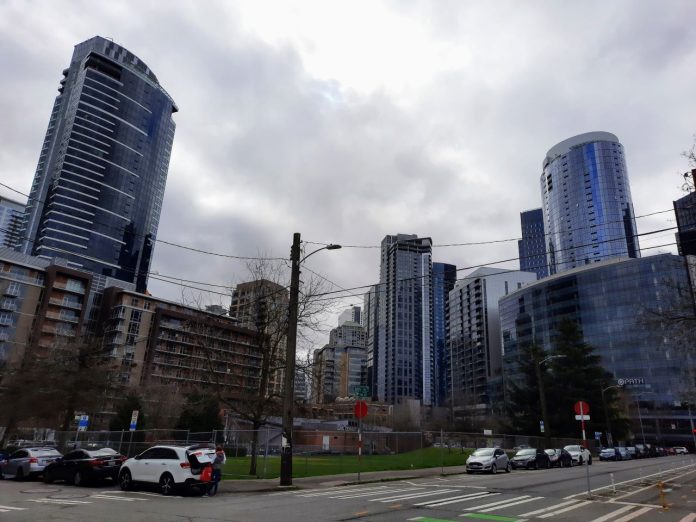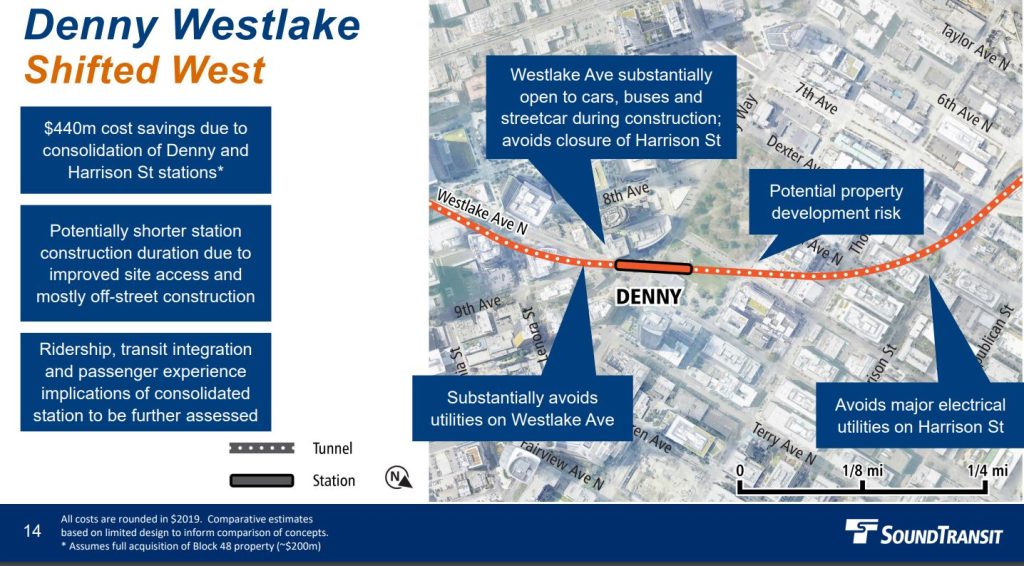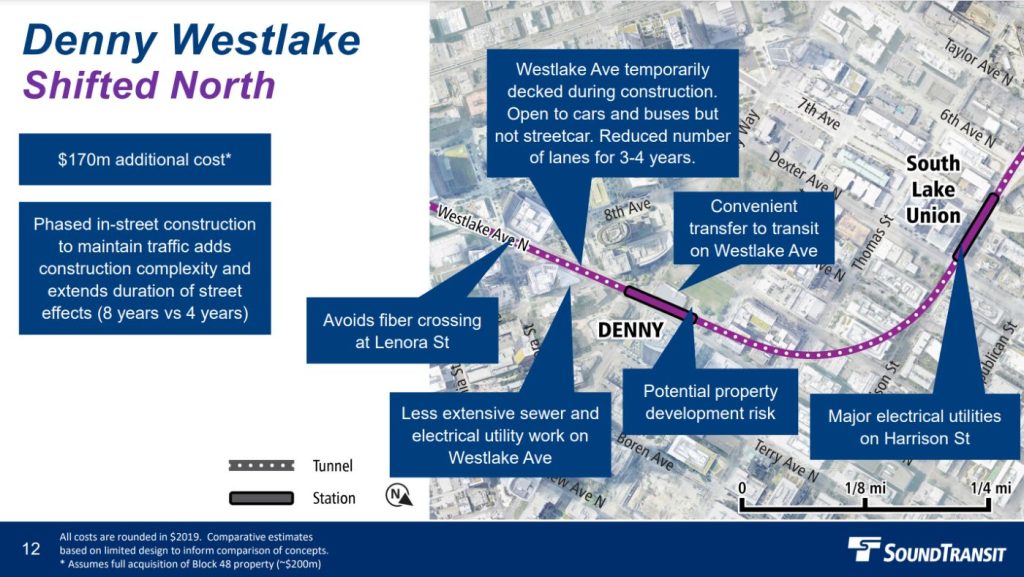
The Sound Transit Board approved Harrell’s motion to make Shifted North the preferred alternative.
Seattle Mayor Bruce Harrell put his weight behind the “Shifted North” alternative for a planned light rail station in Denny Triangle via a Sound Transit Board motion making it the preferred alternative in the ongoing study. The new preference constitutes his third different stance in the space of a month, as the agency struggled to come to consensus over Ballard Link station options. While the station would still be underneath Westlake Avenue, the late-breaking alternative would shift the location of Denny Station from the “DT-1” alternative just south of Denny Way to just north of it. The motion removed the Terry Avenue alternative from the study largely in response to utility risks that emerged.
“I am recommending we continue to move forward with the two stations in South Lake Union and modify the preferred alternative and then in Westlake to the Shifted North alternative,” Harrell said at the board meeting Thursday. “Now what does that do? As we said, number one, it’s our goal to make sure that we still have activity in this area. It never fully closes, there will be times where it’s partially restricted but in terms of the impacts on small businesses, large businesses, just common sense to and from activity. We think this is about as good as we’re gonna get and we’ll look at all the alternatives to reduce the construction impacts by keeping the streets open during the duration of construction. And we’ve already talked the the loss of the 8,000 daily Link trips for future riders.”
Sound Transit estimates the unvetted option will cost an additional $170 million over the DT-1 alternative, but the agency is confident it could reopen Westlake Avenue to traffic much sooner by using decking over the station pit. The motion vaguely alludes to third-party funding that the City of Seattle and King County would provide, which hasn’t yet been laid out in detail. Pierce County Executive Bruce Dammeier sought assurances from Harrell that the City of Seattle would pony up the full amount of the added cost of Shifted North, but didn’t get them.
“If you’re asking me if the City of Seattle is going to write a $170 million check? No, but we will do everything possible to we realize that by moving it shifted north. That is going to be a cost we will work in terms of surplus properties and available tools we work aggressively to shore up that delta,” Harrell said. “And quite frankly, I am making the bold move to make a decision today on the preferred alternative. And let me let me also say I appreciate the patience you’ve had. I don’t take that lightly. You will all have given us the time to explore Shifted West. Thank you on behalf of 800,000 people that rely on the economic generation of this. Thank you. This is a tough decision.”
Snohomish County Executive Dave Somers initially opposed Harrell’s motion and argued for consolidating the Denny Triangle and South Lake Union stations via the Shifted West alternative, which the agency currently projects to save $440 million in its early estimates. Somers said in his view it was fine that an estimated 8,000 Link boardings would shift to slower buses struggling through highly congested streets in the area without the other station.
Somers proposed an amendment to add Shifted West into the study and that amendment was approved, though several board members, including Harrell, King County Executive Dow Constantine, state transportation secretary Roger Millar, and King County Councilmember Claudia Balducci, noting their opposition to dropping a station in South Lake Union. Constantine requested that the agency look in Shifted West options to keep the Harrison Station. With his amendment added, Somers supported the underlying motion.
The agency has indicated that a four-year full closure of Westlake Avenue would be necessary with the DT-1 Alternative location, which remains in the study, though without the “preferred” tag. That construction impact has stirred up strong resistance from several landowners and employers in the area, led by Seattle’s largest employer, Amazon, and Vulcan, one of its largest developers responsible for redeveloping 60 acres of South Lake Union and Denny Triangle, including much of Amazon’s headquarters.
In a public statement released Wednesday, Amazon restated its opposition to building a light rail station on Westlake Avenue, arguing it would devastate local businesses (itself included), and reiterated its support for a last-minute Shifted West alternative that emerged, putting the station a couple blocks to the northwest.

“The current plan calls for a new station on Westlake Avenue. This option will shut down this main artery in downtown Seattle for at least four full years. It will make mobility for our employees, neighbors, and visitors incredibly difficult, greatly increasing traffic and negatively impacting local businesses,” Amazon wrote. “As we’ve all started to see our city, foot traffic, and businesses begin to bounce back, we’re mindful that now we cannot lose that momentum.”
Sound Transit said Shifted West would preclude building the neighboring South Lake Union station at 7th Avenue and Harrison Street, serving more than 10,000 daily riders and offering high quality transfers with the busy bus corridor on Aurora Avenue. After Mayor Harrell briefly backed that option at the urging of Amazon, Vulcan, and other major employers, transit advocates spoke out in large numbers (including a petition with more than 6,000 signatures) rallying against dropping the South Lake Union station from the line and delaying plans with endless study.
The motion notes the following:
— The Urbanist (@UrbanistOrg) July 26, 2023
1. Denny Westlake Shifted North alternative as preferred
2. Denny Station on Westlake (DT-1) Draft EIS station alternative as another option to be studied
3. Denny Station on Terry alternative as removed from further study pic.twitter.com/GQCDPE8O6b
Mayor Harrell then backed the Westlake Avenue alternative at the July 13 meeting. However, the motion shared in advance of today’s meeting (July 27) revealed his changed preference to Shifted North, which he reiterated at the meeting. Since they weren’t in the original study, electing to add either Shifted West or Shifted North to the plan would require redoing the Draft Environment Impact Statement (EIS) which would likely mean a year of delay to planning. However, since the board is also adding new alternatives in and around Chinatown, that new Draft EIS would need to happen anyway.

Faced with opposition to consolidating the stations, Amazon asked Sound Transit to reexamine the issue and see if it could engineer and justify two stations within a quarter mile of each other with a sharp turn between.
“That’s why we are urging the Sound Transit Board to support the ‘Denny Station Shifted West’ option without impacting the proposed Harrison Station. This new location, in the same block as the current plan, will allow for better access to the neighborhood during the several years of construction. We encourage the Board to not rush their decision and at least be willing to consider and study alternative options so we can ensure the expansion of public transit in the neighborhood without having to shut down economic activity in the area for several years.”
The presence of the large Vulcan-owned South Lake Union Discovery Center site next to the Shifted North station site apparently clears the way for the decking plan, since the adjoining off-street site could be used for construction staging. Granted, Vulcan has an extensive redevelopment plans for the site, which it has dubbed Block 48, including an office tower and 41-story apartment tower. Acquiring that site will certainly not be cheap, and Sound Transit has preliminarily budgeted approximately $200 million for the acquisition. The decking would allow buses and cars to continue to use Westlake Avenue on reduced lanes, but the South Lake Union streetcar wouldn’t run through the construction zone in either scenario and would need to be truncated until the street is rebuilt.
Sound Transit has not yet devised a way to do the same at the DT-1 because the site is surrounded by already-constructed high-rises, including part of Amazon’s headquarters, which makes the surrounding blocks very expensive to acquire and disruptive to demolish. Thus, the agency believes it will have to use Westlake Avenue for construction staging, which interferes with the decking idea according to an agency spokesperson.
While a smaller off-street staging site could be a hurdle, it’s still not fully clear why decking would not work with the already-studied DT-1 Denny and Westlake station. Sound Transit has acknowledged it could use neighboring side streets for staging which seems like a worthy strategy to pursue in order to devise a plan to reduce construction impacts on Westlake Avenue. However, the agency’s assessment of decking is more feasible with Shifted North.
The direction from the Sound Transit Board means the agency will embark on further study to generate a new Draft EIS including the two new as-of-yet unvetted alternatives to the Draft EIS. This comes with the prospect of further delaying the project. While that line was originally slated to open in 2035, planning delays have already made 2039 the best case scenario according to the agency. However, board members stressed the need to get the planning right and forge ahead with a good plan that avoids delay further down the road.
Hopefully that is the result of the new Draft EIS, but there are no guarantees.
Doug Trumm is publisher of The Urbanist. An Urbanist writer since 2015, he dreams of pedestrian streets, bus lanes, and a mass-timber building spree to end our housing crisis. He graduated from the Evans School of Public Policy and Governance at the University of Washington in 2019. He lives in Seattle's Fremont neighborhood and loves to explore the city by foot and by bike.

